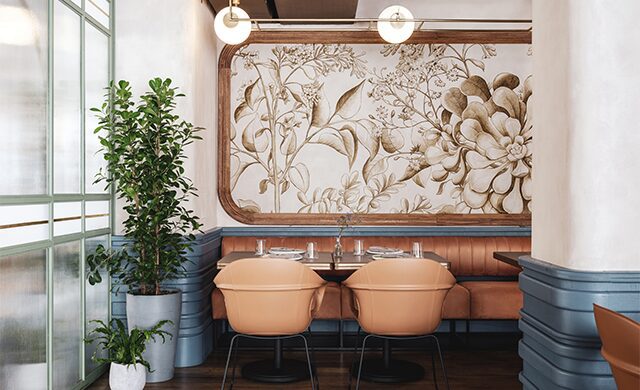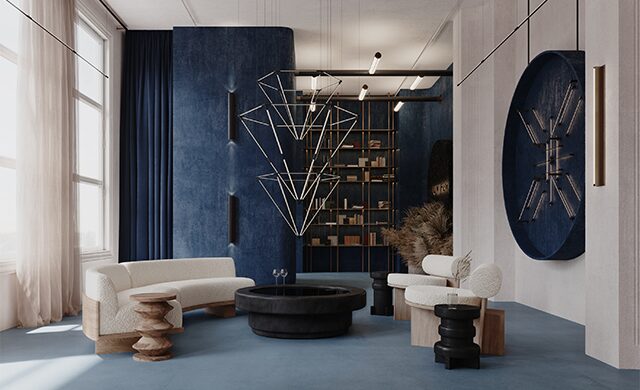Though an ocean apart, Julien Albertini and Alina Pimkina both grew up in environments that fostered and enabled their creative sides. In 2016, when Brooklyn-born Albertini and the Moscow-reared Pimkina met in New York, it was kismet. They launched Asthetíque that same year, and have made a big impact on the industry in a short period of time with projects like Café Polet in Moscow. Inspired by a 1960s airport lounge, the restaurant provides a glimpse into the firm’s holistic approach, which prizes a thoughtful design vernacular above all else.
First design memories
Born in Brooklyn’s Brownsville neighborhood and raised in Long Island, New York, Albertini knew he wanted to be an architect after watching his dad design retail stores around the world as head of design at PVH (formerly Phillips-Van Heusen). Going to open houses and visiting new developments with his mom opened up his eyes to “how you can create a whole experience that seems to be cut off from the regular world,” he explains.
On the other side of the world, Pimkina was surrounded by a family of artists who encouraged a “creative and free atmosphere,” she says. Trips to the local grocery store, Eliseevsky, with her grandmother solidified her love of design. “I was intrigued and fascinated by the historical beauty” of the 1901-built space, she says. “Even a plain éclair became something exotic because of the store’s atmosphere. That experience gave birth to an intimate understanding of how design influences us and our perception of things.”

Floral art mingles with leather, wood, and brass in Y restaurant in Moscow
Early beginnings
With a degree in interior design from Orel State University in Russia, Pimkina found herself working at Russian creative studio MTV, which “helped me see the world from different angles,” she says. Creativity “makes the world a more beautiful and better place. In my experience, people who are connected to the creative process are usually good people.” She worked at another Russian firm, BBDO, before joining restaurant group, Ginza Project, as creative director, where she built out the design department and new concepts for the Russian market.
Meanwhile, after attending the New York Institute of Technology for architecture, Albertini started his own company, Albertini Design, where he co-designed Calvin Klein stores and built high-end residences and offices during the day while promoting New York nightclubs at night as a means to meet new clients. Of that early experience, he says he learned that his “job as a designer is not only to craft beautiful spaces, but to also be a businessperson with excellent customer service skills.”
On launching Asthetíque
After meeting through Pimkina’s husband, Albertini and Pimkina recognized they spoke the same design language. “We’re totally in love with design and both hard workers and dreamers,” Pimkina says. “It’s a great partnership because there’s a real balance between us,” adds Albertini. Together, they encourage as much as they rely on each other. “It’s a wonderful and precious thing to have a great partner,” says Pimkina. “Our synergy is in the DNA of Asthetíque.”

A rendering of Café MX in Mexico City, which will feature statement-making lighting
On hospitality today
The duo is drawn to hospitality because it’s an opportunity to “create not only spaces but also experiences and memories,” says Pimkina, who points to the Y restaurant in Moscow as “the perfect example of how design can have a positive influence on people and their emotions. Everyone says their mood improves when they cross the threshold of the restaurant.” As the firm takes on more projects, the designers are also finding that it’s their job to push boundaries, think outside the box, and expand their comfort zones. “The more we experience design, the more we want to create,” Albertini says.
On finding inspiration
Albertini looks to his architect father as well as his soon-to-be father-in-law, who works in finance, for guidance in finding balance as he grows into his career. The multidisciplinary firm AvroKO has also influenced the duo, showing them how to “craft a strong brand while being [savvy] businesspeople,” he says. As Asthetíque’s vision evolves (both dream of building a whole community), they define success as “waking up every morning to appreciate the beauty and excitement that each new day will bring,” Pimkina says.

A cool color palette lets the products stand out at Juniper’s New York showroom
Photos and renderings by Mikhail Loskutov, Petro Onysko, and Asthetíque
This article originally appeared in HD’s July 2020 issue.


